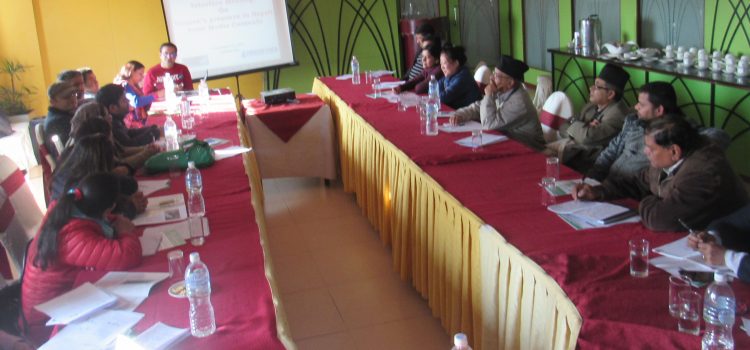Freedom Forum conducted the third round of interface on ‘Women’s presence in Nepali Print Media contents’ in Kathmandu on December 13. The program gathered 35 people including media persons, government officials, advocates, and representatives from CSOs.
At the program, FF’s Media Monitoring Officer made a presentation on monitoring of media contents- byline and news sources- to see women’s presence in nine major national dailies. The 11-month long monitoring report revealed that only 5.32 percent byline stories among the total of 3,965 news bylines during the reviewed period were of or on females, while women were quoted as sources in only 9.25 per cent news of the broadsheets. It was also found that males were quoted as news sources in 53.01 per cent news.
The report also says that majority of the news contents in the main pages were related to politics and government.
Introducing the objective of program, FF’s Executive Chief Mr Taranath Dahal stated that the study and its results produced were aimed at sensitizing stakeholders about maintaining gender equality in their media and contents as well. Although the initial report had painted poor picture, it has gradually improved, he added.
During the program, various speakers underscored the need of increasing women as news source in Nepali media. They also emphasized the need to augment the reporters in Nepali media industry.
On the occasion, Director at Department of Information Ms Suman Bajracharya pointed out the need of adopting a policy to mandatorily appoint 33 per cent women in media as it has been already in practiced in government services. She further informed that among total 5,312 journalists given accreditation by Department of Information, there were only 593 (11.16%) females.

Federation of Nepali Journalist (FNJ) Vice-President Mr Bipul Pokharel, praised the study report, for bringing such analytical data on gender imbalance on major media. He suggested FF that it could expand such study to the local level media as well.
“It helps FNJ as a good reference for further planning to increase women’s participation in journalism,” he added.
Senior Sub-Editor at Annapurna Post daily (which is also included in FF’s study report), Mr Prakash Timsena, argued that males were insensitive to women’s issues in most of the cases and so is in media. “However, Annapurna Post is committed to encouraging female reporters in its contents and media house too”, he underscored.
Senior business reporter at the same daily, Ms Menuka Karki, shared it was difficult to find female sources for business news and if found they were not able to speak on the contents. She also suggested FF to include business page, and business related newspapers in the study, so that the number of women reporters could be found more.
Adding to Karki’s experience, Nagarik’s reporter Ms Bhasha Sharma argued that women journalists were not less capable than their male counterparts but the problem lies in bringing women to contact as a source of news. She further recommended studying the number of reporters on the basis of their reporting on the specified topics.
Reasoning the reflection of patriarchal mindset in Nepali media, English Desk Editor at the National News Agency (RSS), Ms Pabitra Guragain, complained that women were not referred as experts yet in any field. Security threats are also more to females than males in Nepali media.
Information Officer at the National Women Commission, Mr Dhrubaraj Chhetri, said that women journalists needed more convenient and comfortable atmosphere than male ones to become reporters and editors.
Antenna Foundation’s Executive Director Mr Binaya Guragain suggested FF adding more qualitative aspect to the study and supporting media houses to plan and formulate guidelines.
Concluding the program, FF Chairperson Hari Binod Adhikari urged the media houses to play constructive role to retain women journalists in the industry.
The program held in Kathmandu this time witnessed more number of women participants- 20 females where there were 15 males.

